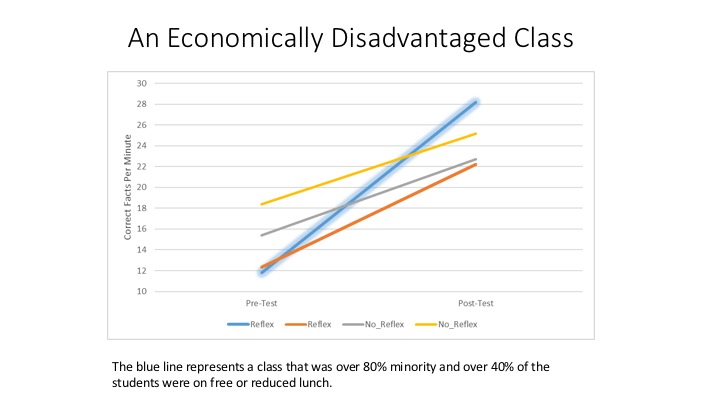
In the spring of 2016, students at an elementary school in Broward County Public Schools in Florida participated in a math fact fluency study over the course of 101 days. The study was set up to compare Reflex, an online individualized game-based math fact fluency system, to traditional classroom methods for teaching math fact fluency.
The study included 139 students in grades 2 and 3. At each grade level, two classes used Reflex and the other two classes used different strategies such as flashcards, timed tests, the program TenMarks, and worksheets to learn their math facts.
Setting
The Broward County Public School District is located in metropolitan Fort Lauderdale, approximately 30 miles north of Miami. It is the sixth-largest public school system in the United States. The elementary school in Broward where the study took place is a minority-majority school. 57% of its 2nd- and 3rd-grade students are Hispanic or Latino, 31% are Caucasian, 28% have low English proficiency, and 17% are on free or reduced lunch.
Participation
The median Reflex student spent 58 minutes a week using the system, which included any time spent on it outside of class. Teachers in non-Reflex classes reported that their students spent between 50 and 280 minutes a week (counting time in class and at home) developing math fact fluency.
Fluency Measurement
Students were tested on their fluency with math facts based on the Florida Standards requirements for their grade level, which are identical to those in the Common Core Math Standards.
- Students in grade 2 were tested on addition/subtraction facts up to 10 + 10 and 20 – 10.
- Students in grade 3 were tested on multiplication/division facts up to 10 x 10 and 100 ÷ 10.
Paper-based tests were used to measure the fluency of each student before and after the study. Three one-minute tests were given at the beginning and again at the end of the study. The results from the three tests at the beginning were averaged to make the pretest score. The three tests at the end were averaged to make the students’ post-test scores. In the tests, students were scored on both their speed and accuracy. A student’s raw fluency score was calculated as the average number of correct digits minus the average number of incorrect digits across these three tests.
Results
Overall Results
Users of Reflex showed gains approximately 140% greater than non-users of Reflex on the Posttest.
| Average Fluency Scores | ||
| Average Raw Fluency Scores (Non-Gifted Classes) | ||
| Comparison Group | Reflex Group | |
| Average Pretest | 17.21 | 16.35 |
| Average Post-test | 21.09 | 29.56 |
| Average Gain | 3.88 | 13.22 |

Results from economically disadvantaged class
In a 3rd-grade class that was 41% free and reduced lunch, 64% female, 82% minority, and 12% low English proficiency, students using Reflex were able to improve their test scores from 11.8 correct facts per minute to 28.18 correct facts per minute, passing the other classes labeled as “high achieving/gifted” classes. In this economically disadvantaged class, more than half of the students finished in the top quarter of all 3rd-graders in the study at post-test.
The class is shown as a blue line, starting with the lowest pretest score and ending with the highest post-test score. The teacher of this Reflex class commented that her students “had more confidence in their fluency and had a positive attitude toward math” after using Reflex.
Conclusion
This study shows that consistent use of Reflex helps 2nd- and 3rd-grade students improve their math fact fluency more quickly and more effectively than a variety of other math fact fluency methods in use at the school.
Read the full study for more.
Sign up to get the latest updates from ExploreLearning via occasional email.